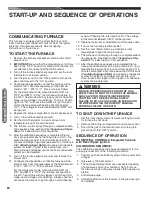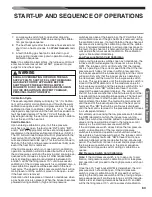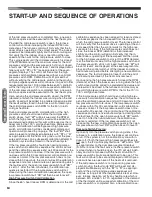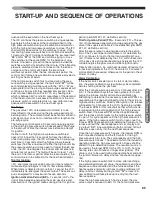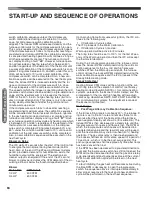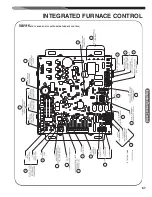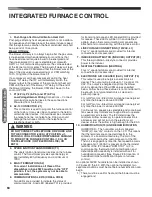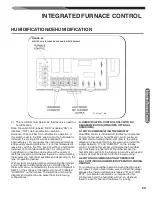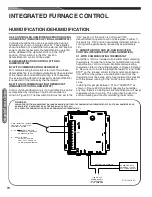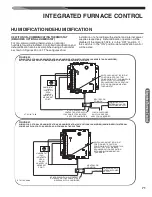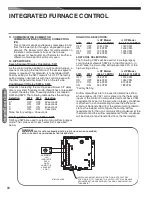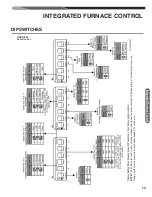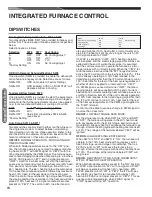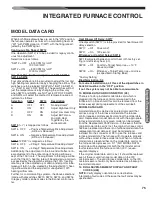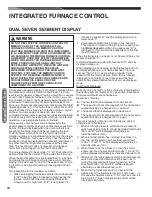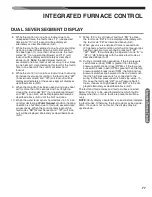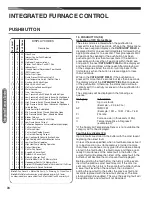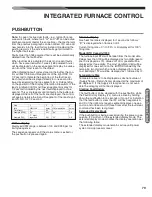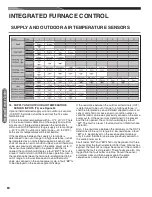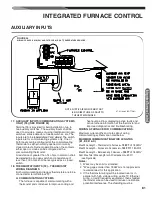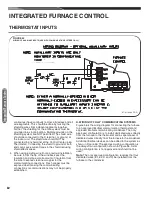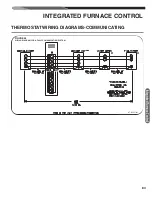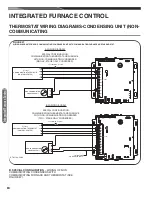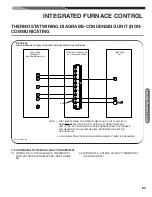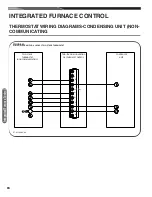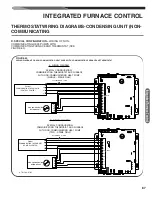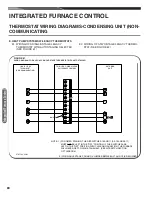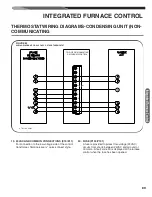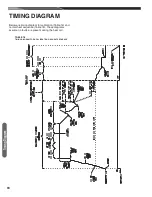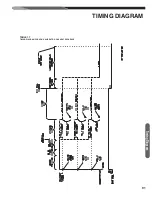
76
In
te
gr
at
ed
F
ur
na
ce
C
on
tro
l
INTEGRATED FURNACE CONTROL
DUAL SEVEN SEGMENT DISPLAY
A dual seven-segment display is provided to display status
and diagnostic code information. A fault level 1 is a low-
level fault. In general, a level 2 fault is a fault that is severe
enough that it prevents furnace or other critical (e.g. cool-
ing) operation. Level 1 faults generally permit operation to
continue but operation may not be at optimum perform-
ance (e.g. blower operating at power maximum). Standard
operating codes (e.g. C for high-stage cooling) are consid-
ered fault level “0” as they are not faults at all but only indi-
cations of current modes of operation which are
considered normal (some operational codes are displayed
simultaneously with low-level faults which do not interrupt
operation - see paragraphs below for details).
Since usually only one fault can be displayed at the
seven-segment display at any given time (see exceptions
below), the fault displayed when two or more faults are
present at the same time shall be resolved by the fault
code list below which calls out the fault code priority.
Smaller numbers are considered higher priority than larger
numbers. Therefore, fault code priority 1 has the highest
priority and shall be displayed when present regardless of
any other fault that might also be present at the same
time. This mechanism does not prevent simultaneous
faults from being logged into the fault code buffer.
The mode displays for heat mode (“h” “H”) shall reflect the
demand from the thermostat. This includes the following:
When thermostat demand is interpreted as 40% gas heat
and during the ignition period the furnace control will dis-
playing the lower-case “h” and not the upper-case “H” dur-
ing ignition (since the modulating furnace ignites at high
stage).
Two exceptions to this rule exist as follows:
1. When autostaging has been activated and a response
to “W1” heat has been increased to high heat by the
furnace control after the user-specified time even
though a call for high heat (“W2”) is not present. In
this case a capital “H” shall be displayed and not a
lower-case “h”.
2. Low pressure switch fails 5 times in one heat call.
Then device is forced to the high rate to reveal possi-
ble
Water Sensed
condition. An upper-case “H” is
displayed in this circumstance regardless of the ther-
mostat demand.
When the furnace is in a heat or cool blower off delay, the
display should be “0”.
A standard operating code (with fault level “0”) shall be
displayed steady-on.
When displaying a fault code, it shall be flashed and not
be displayed steady-on. It shall be flashed on for one
second, then off for ½ second then on again. Cycle
repeats until the fault is cleared. Each fault is flashed
(displayed) a minimum of two times even if the fault
condition has cleared before the fault can be displayed
twice.
Dual Faults Displayed
Normally only one fault or status character is displayed at
the Seven-segment display at any given time. Exceptions
for some dual faults are noted below.
Sequence of display:
A.
The first fault will be displayed for one second.
B.
The upper-most horizontal segment of the right seven-
segment display is energized for ½ second.
C.
The second fault is displayed for one second.
D.
The upper-most horizontal segment of the right seven-
segment display is energized for ½ again.
This cycle repeats until one or both faults are gone or
otherwise as noted below:
1. When both high pressure switch and low pressure
switch are open and both should be closed fault codes
“45” and “57” will be displayed alternately as
described above (A-D).
2. When a failed ignition has occurred four times in a
row, the control enters one-hour lockout and fault
codes “10” and “11” will be displayed alternately as
described above (A-D).
3. When flame is lost five times in a row, the control
enters one-hour lockout and fault codes “10” and “13”
will be displayed alternately as described above (A-D).
4. When both the high pressure switch and low pressure
switch are closed and both should be open (as in
during the pressure switch proving period). In this
case fault codes “44” and “55” will be displayed
alternately as described above (A-D).
5. When the high pressure switch is open and the
demand from the thermostat is set to 100% heat. . . In
this case the operation code “h” (for low heat) and the
fault code “57” (open high pressure switch) will be
displayed alternately.
!
WARNING
DO NOT REPLACE THE FURNACE CONTROL OR
MEMORY CARD OF THE FURNACE WITH A
FURNACE CONTROL OR MEMORY CARD OF
ANOTHER FURNACE OR ANOTHER COMPONENT
(E.G.: A MEMORY CARD FROM A CONDENSER OR
AIR HANDLER). THE WRONG FURNACE CONTROL
OR MEMORY CARD MAY SPECIFY PARAMETERS
WHICH WILL MAKE THE FURNACE RUN AT UNDE-
SIRED CONDITIONS INCLUDING (BUT NOT
NECESSARILY LIMITED TO) REDUCED AIRFLOW
DURING HEATING CAUSING EXCESSIVE
UNDESIRED OPERATION OF THE MAIN LIMIT
CONTROL. FURTHER, THE MEMORY CARD IS
SPECIFIC TO THE MODEL NUMBER AND BTU
INPUT RATING FOR A SPECIFIC FURNACE AND
THIS INFORMATION SHOULD NOT BE
TRANSPORTED FROM ONE FURNACE (OR
COMPONENT) TO ANOTHER.

